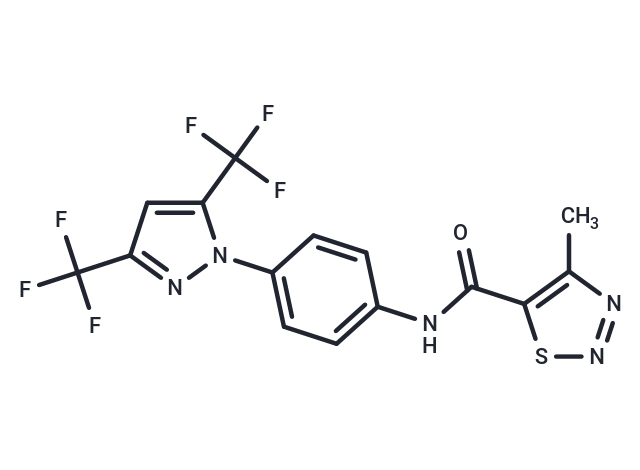Shopping Cart
- Remove All
 Your shopping cart is currently empty
Your shopping cart is currently empty

YM-58483 (BTP2) is a specific and effective inhibitor of CRAC channels and subsequent Ca2+ signals.

| Pack Size | Price | Availability | Quantity |
|---|---|---|---|
| 1 mg | $30 | In Stock | |
| 2 mg | $43 | In Stock | |
| 5 mg | $68 | In Stock | |
| 10 mg | $117 | In Stock | |
| 25 mg | $239 | In Stock | |
| 50 mg | $405 | In Stock | |
| 100 mg | $590 | In Stock | |
| 1 mL x 10 mM (in DMSO) | $63 | In Stock |
| Description | YM-58483 (BTP2) is a specific and effective inhibitor of CRAC channels and subsequent Ca2+ signals. |
| In vitro | In various models of allergic asthma, including airway hyperresponsiveness, early and late-phase bronchoconstriction, and antigen-induced airway eosinophilia, YM-58483 demonstrates inhibitory effects. Furthermore, in rat and guinea pig tissues, it reduces levels of leukotrienes and IL-4. In mice with GVHD, YM-58483 also suppresses host-versus-graft CTL reactions, donor T cell proliferation, and the production of IFN-γ. Notably, YM-58483 (30 mg/kg, p.o.) does not significantly affect general activity in mice [1]. |
| In vivo | As a selective SOCE inhibitor, YM-58483 inhibits sustained calcium ion influx induced by anti-CD3 antibodies in Jurkat T cells. It inhibits CRAC, TRPC3, and TRPC5 channels, while promoting the TRPM4 channel, leading to the suppression of cytokine production (IL-2, IL-4, IL-5, IFN-γ, etc.) and T-cell proliferation. YM-58483 impedes the proliferation of splenocytes related to MLR by inhibiting the activation of NF-AT[1]. Additionally, it significantly suppresses the production of IL-2 and the promoter activity driven by NF-AT, without affecting the AP-1-driven promoter activity within Jurkat cells[2]. |
| Kinase Assay | HCT-116 cells are washed with PBS and then homogenized with a 27-gauge syringe in binding buffer (10 mm Tris-HCl (pH 7.4), 50 mm KCl, 5 mm MgCl2, 1 mm EDTA, and 0.1 mm Na3VO4). The cell lysate is centrifuged at 13,000 rpm for 30 min at 4°C, and the supernatant is collected. The HCT-116 cell lysate supernatant is precleared by incubating with Dynabeads M-280 streptavidin for 30 min at 4°C and captured by magnet separation. The cleared supernatants are incubated with biotinyl-KRIBB11 compound. After overnight incubation at 4°C, proteins associated with the biotinyl-KRIBB11 compound are precipitated with Dynabeads M-280 streptavidin. Precipitated samples are separated by a magnet. Samples are washed with 1 mL of ishing buffer containing 50 mm HEPES (pH 7.5), 50 mm NaCl, 1 mm EDTA, 1 mm EGTA, 0.1% Tween 20, 10% (v/v) glycerol, 1 mm NaF, 0.1 mm Na3VO4, and protease inhibitor mixture tablets (1 tablet/10 mL). Samples are boiled in SDS-PAGE sample buffer, separated by 10% polyacrylamide gel, and immunoblotted with antibodies against HSF1, HSF2, HSP90, or CDK9. |
| Cell Research | Jurkat cells (1×107 cells/ml) were tested with varying concentration of compounds for 30 min at 37°C. The cells were stimulated with 1 μM ionomycin for 30 min at 37°C. After stimulation, the cells were centrifuged at 200×g for 2 min, and were solubilized in 100 μl of Triton X-100 lysis buffer. The cell lysate was centrifuged at 15,000×g for 20 min; the clarified lysate was subjected to SDS-PAGE; and NF-ATc2 was detected by Western blotting with anti-NF-ATc2 mAb. (Only for Reference) |
| Alias | YM 58483, BTP2 |
| Molecular Weight | 421.32 |
| Formula | C15H9F6N5OS |
| Cas No. | 223499-30-7 |
| Smiles | Cc1nnsc1C(=O)Nc1ccc(cc1)-n1nc(cc1C(F)(F)F)C(F)(F)F |
| Relative Density. | 1.63 g/cm3 (Predicted) |
| Storage | Powder: -20°C for 3 years | In solvent: -80°C for 1 year | Shipping with blue ice/Shipping at ambient temperature. | |||||||||||||||||||||||||||||||||||
| Solubility Information | Ethanol: 78 mg/mL (185.13 mM), Sonication is recommended. H2O: < 1 mg/mL (insoluble or slightly soluble) DMSO: 78 mg/mL (185.13 mM), Sonication is recommended. | |||||||||||||||||||||||||||||||||||
Solution Preparation Table | ||||||||||||||||||||||||||||||||||||
Ethanol/DMSO
| ||||||||||||||||||||||||||||||||||||

Copyright © 2015-2025 TargetMol Chemicals Inc. All Rights Reserved.